Case Study Analysis: Real Madrid Club de Fútbol - Business Development
VerifiedAdded on 2022/08/17
|9
|1804
|16
Case Study
AI Summary
This assignment analyzes the Real Madrid Club de Fútbol case study, focusing on its business model, competition, and marketing strategies. The analysis covers the club's history, including the incorporation in 1902 and key player acquisitions like David Beckham. It examines revenue streams, customer segmentation, and the club's vision and mission. The discussion delves into the competition from clubs like Manchester United and evaluates Real Madrid's success factors, including player performance, sponsorships, and promotional strategies. The marketing mix elements (product, promotion, price, and place) are analyzed in detail. Finally, the assignment outlines future directions for the club, emphasizing brand expansion, player retention, and capitalizing on fan passion to sustain growth and profitability. The document references several academic sources to support its analysis.
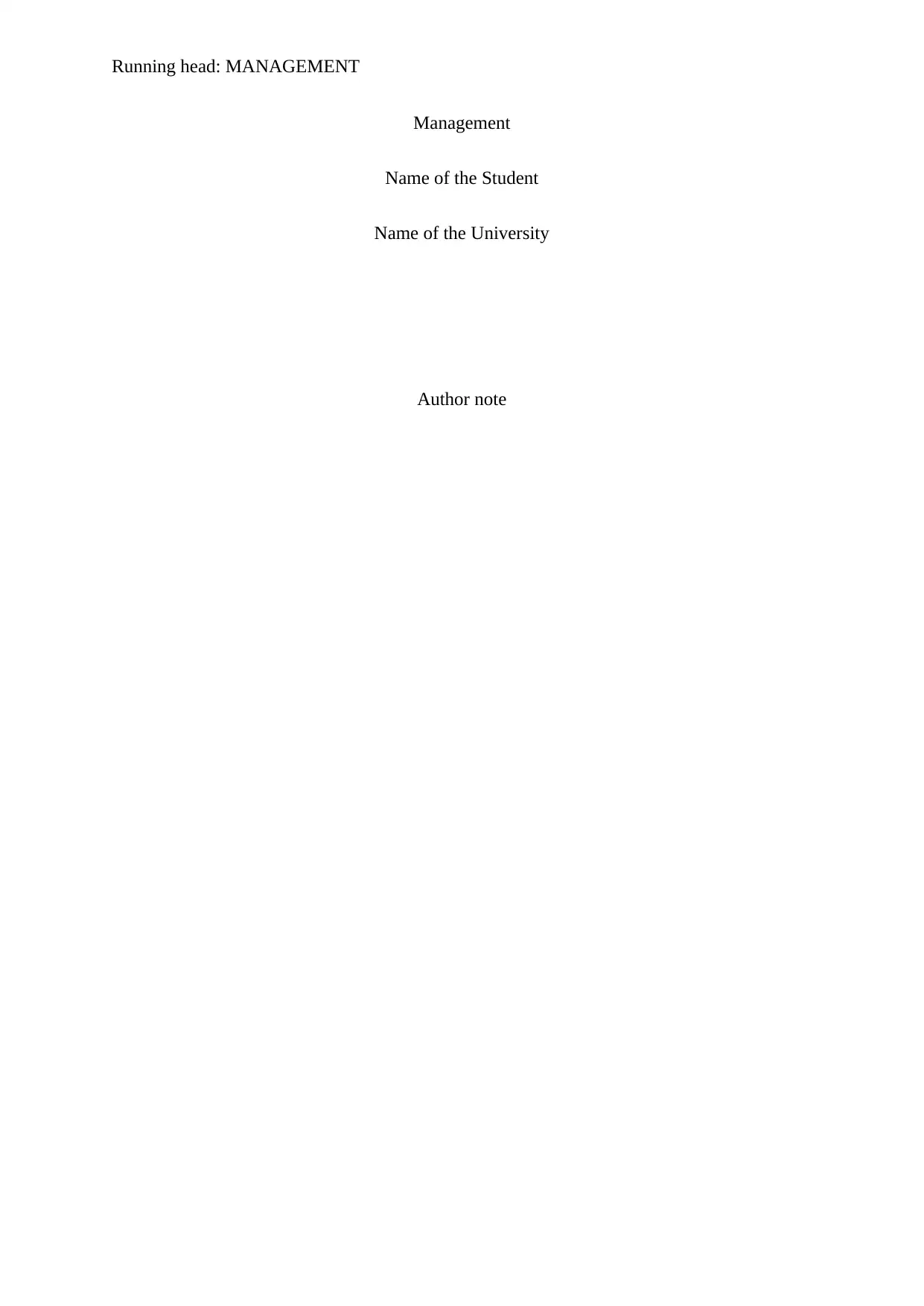
Running head: MANAGEMENT
Management
Name of the Student
Name of the University
Author note
Management
Name of the Student
Name of the University
Author note
Paraphrase This Document
Need a fresh take? Get an instant paraphrase of this document with our AI Paraphraser
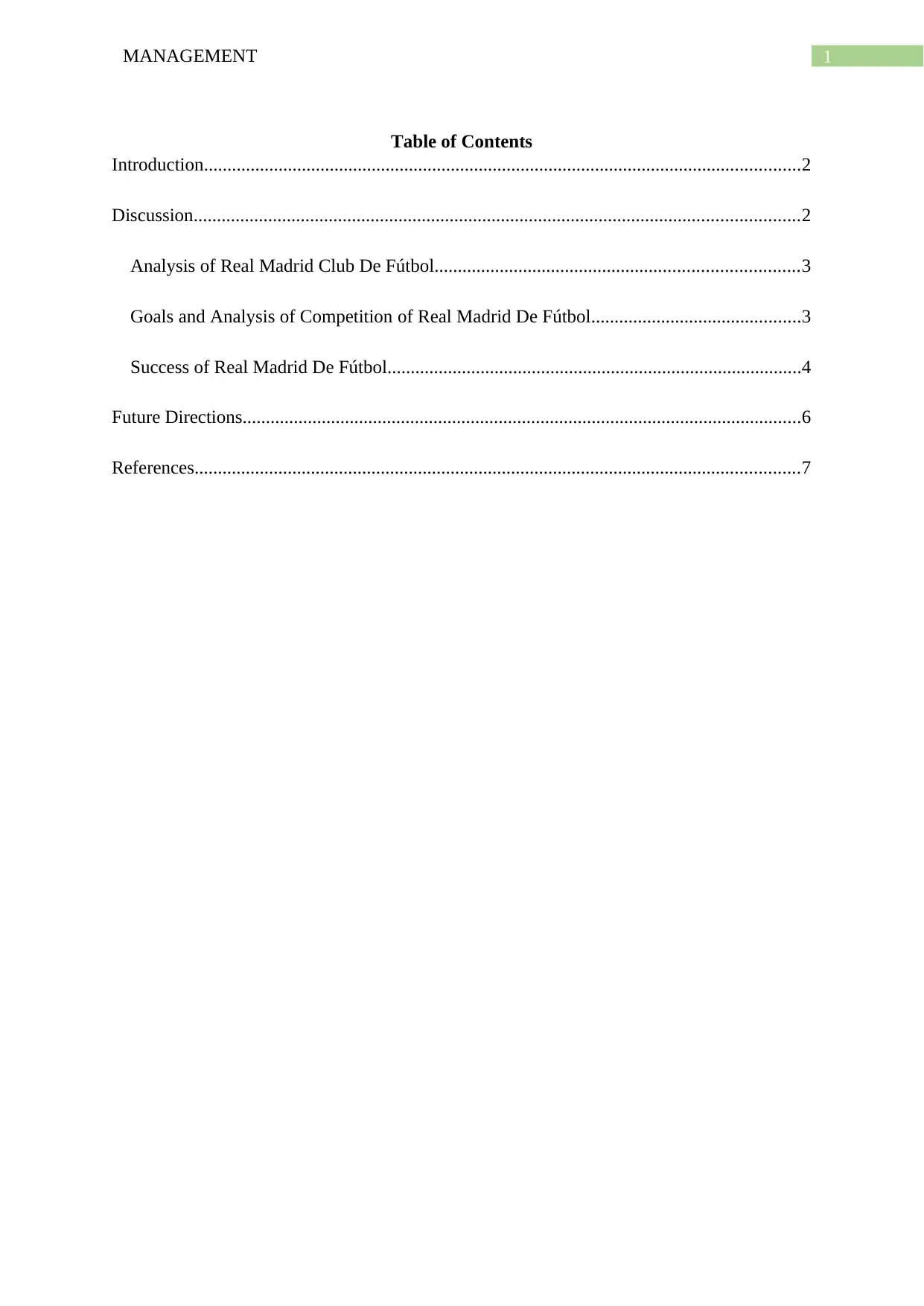
1MANAGEMENT
Table of Contents
Introduction................................................................................................................................2
Discussion..................................................................................................................................2
Analysis of Real Madrid Club De Fútbol..............................................................................3
Goals and Analysis of Competition of Real Madrid De Fútbol.............................................3
Success of Real Madrid De Fútbol.........................................................................................4
Future Directions........................................................................................................................6
References..................................................................................................................................7
Table of Contents
Introduction................................................................................................................................2
Discussion..................................................................................................................................2
Analysis of Real Madrid Club De Fútbol..............................................................................3
Goals and Analysis of Competition of Real Madrid De Fútbol.............................................3
Success of Real Madrid De Fútbol.........................................................................................4
Future Directions........................................................................................................................6
References..................................................................................................................................7
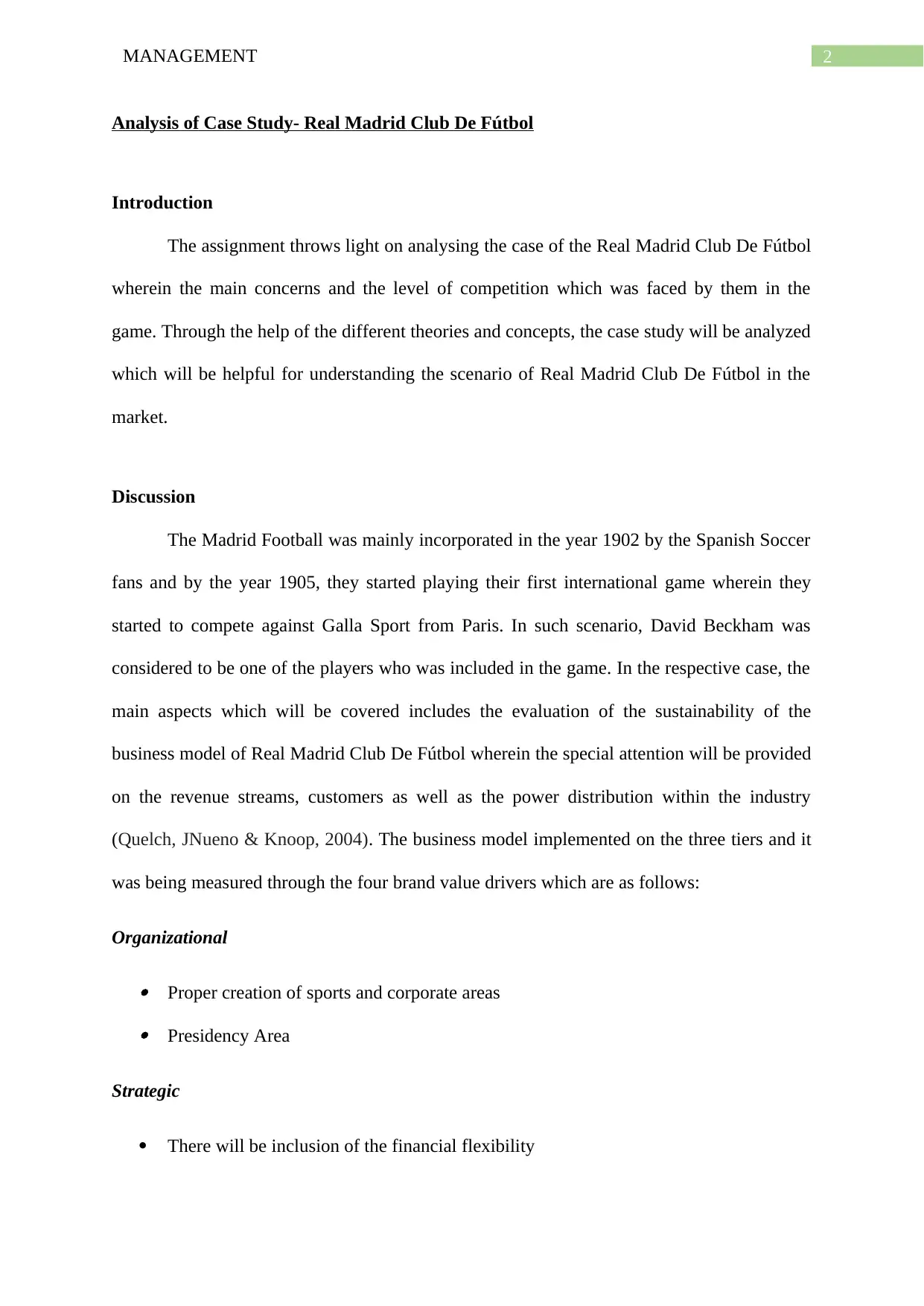
2MANAGEMENT
Analysis of Case Study- Real Madrid Club De Fútbol
Introduction
The assignment throws light on analysing the case of the Real Madrid Club De Fútbol
wherein the main concerns and the level of competition which was faced by them in the
game. Through the help of the different theories and concepts, the case study will be analyzed
which will be helpful for understanding the scenario of Real Madrid Club De Fútbol in the
market.
Discussion
The Madrid Football was mainly incorporated in the year 1902 by the Spanish Soccer
fans and by the year 1905, they started playing their first international game wherein they
started to compete against Galla Sport from Paris. In such scenario, David Beckham was
considered to be one of the players who was included in the game. In the respective case, the
main aspects which will be covered includes the evaluation of the sustainability of the
business model of Real Madrid Club De Fútbol wherein the special attention will be provided
on the revenue streams, customers as well as the power distribution within the industry
(Quelch, JNueno & Knoop, 2004). The business model implemented on the three tiers and it
was being measured through the four brand value drivers which are as follows:
Organizational
Proper creation of sports and corporate areas Presidency Area
Strategic
There will be inclusion of the financial flexibility
Analysis of Case Study- Real Madrid Club De Fútbol
Introduction
The assignment throws light on analysing the case of the Real Madrid Club De Fútbol
wherein the main concerns and the level of competition which was faced by them in the
game. Through the help of the different theories and concepts, the case study will be analyzed
which will be helpful for understanding the scenario of Real Madrid Club De Fútbol in the
market.
Discussion
The Madrid Football was mainly incorporated in the year 1902 by the Spanish Soccer
fans and by the year 1905, they started playing their first international game wherein they
started to compete against Galla Sport from Paris. In such scenario, David Beckham was
considered to be one of the players who was included in the game. In the respective case, the
main aspects which will be covered includes the evaluation of the sustainability of the
business model of Real Madrid Club De Fútbol wherein the special attention will be provided
on the revenue streams, customers as well as the power distribution within the industry
(Quelch, JNueno & Knoop, 2004). The business model implemented on the three tiers and it
was being measured through the four brand value drivers which are as follows:
Organizational
Proper creation of sports and corporate areas Presidency Area
Strategic
There will be inclusion of the financial flexibility
⊘ This is a preview!⊘
Do you want full access?
Subscribe today to unlock all pages.

Trusted by 1+ million students worldwide
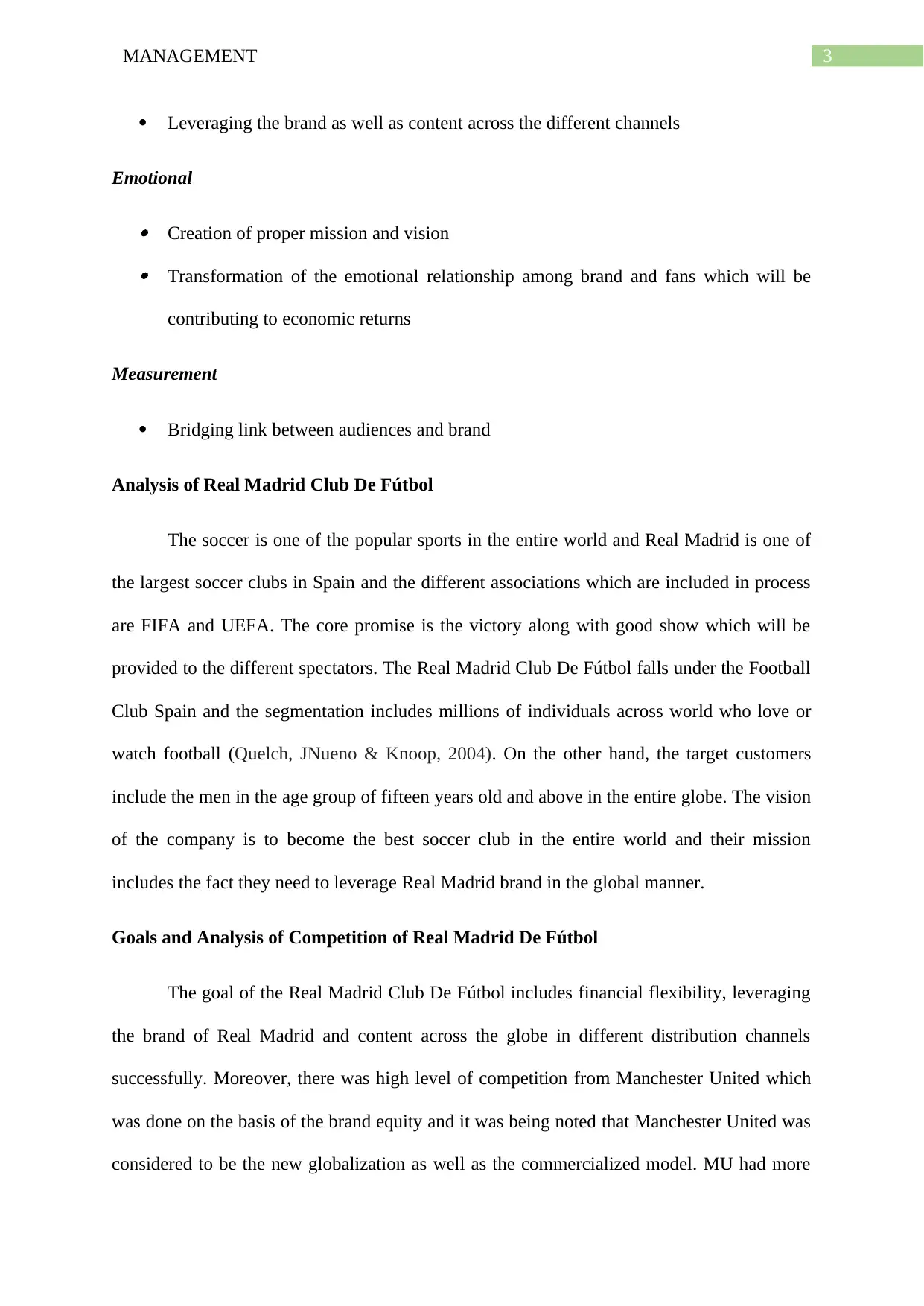
3MANAGEMENT
Leveraging the brand as well as content across the different channels
Emotional
Creation of proper mission and vision Transformation of the emotional relationship among brand and fans which will be
contributing to economic returns
Measurement
Bridging link between audiences and brand
Analysis of Real Madrid Club De Fútbol
The soccer is one of the popular sports in the entire world and Real Madrid is one of
the largest soccer clubs in Spain and the different associations which are included in process
are FIFA and UEFA. The core promise is the victory along with good show which will be
provided to the different spectators. The Real Madrid Club De Fútbol falls under the Football
Club Spain and the segmentation includes millions of individuals across world who love or
watch football (Quelch, JNueno & Knoop, 2004). On the other hand, the target customers
include the men in the age group of fifteen years old and above in the entire globe. The vision
of the company is to become the best soccer club in the entire world and their mission
includes the fact they need to leverage Real Madrid brand in the global manner.
Goals and Analysis of Competition of Real Madrid De Fútbol
The goal of the Real Madrid Club De Fútbol includes financial flexibility, leveraging
the brand of Real Madrid and content across the globe in different distribution channels
successfully. Moreover, there was high level of competition from Manchester United which
was done on the basis of the brand equity and it was being noted that Manchester United was
considered to be the new globalization as well as the commercialized model. MU had more
Leveraging the brand as well as content across the different channels
Emotional
Creation of proper mission and vision Transformation of the emotional relationship among brand and fans which will be
contributing to economic returns
Measurement
Bridging link between audiences and brand
Analysis of Real Madrid Club De Fútbol
The soccer is one of the popular sports in the entire world and Real Madrid is one of
the largest soccer clubs in Spain and the different associations which are included in process
are FIFA and UEFA. The core promise is the victory along with good show which will be
provided to the different spectators. The Real Madrid Club De Fútbol falls under the Football
Club Spain and the segmentation includes millions of individuals across world who love or
watch football (Quelch, JNueno & Knoop, 2004). On the other hand, the target customers
include the men in the age group of fifteen years old and above in the entire globe. The vision
of the company is to become the best soccer club in the entire world and their mission
includes the fact they need to leverage Real Madrid brand in the global manner.
Goals and Analysis of Competition of Real Madrid De Fútbol
The goal of the Real Madrid Club De Fútbol includes financial flexibility, leveraging
the brand of Real Madrid and content across the globe in different distribution channels
successfully. Moreover, there was high level of competition from Manchester United which
was done on the basis of the brand equity and it was being noted that Manchester United was
considered to be the new globalization as well as the commercialized model. MU had more
Paraphrase This Document
Need a fresh take? Get an instant paraphrase of this document with our AI Paraphraser
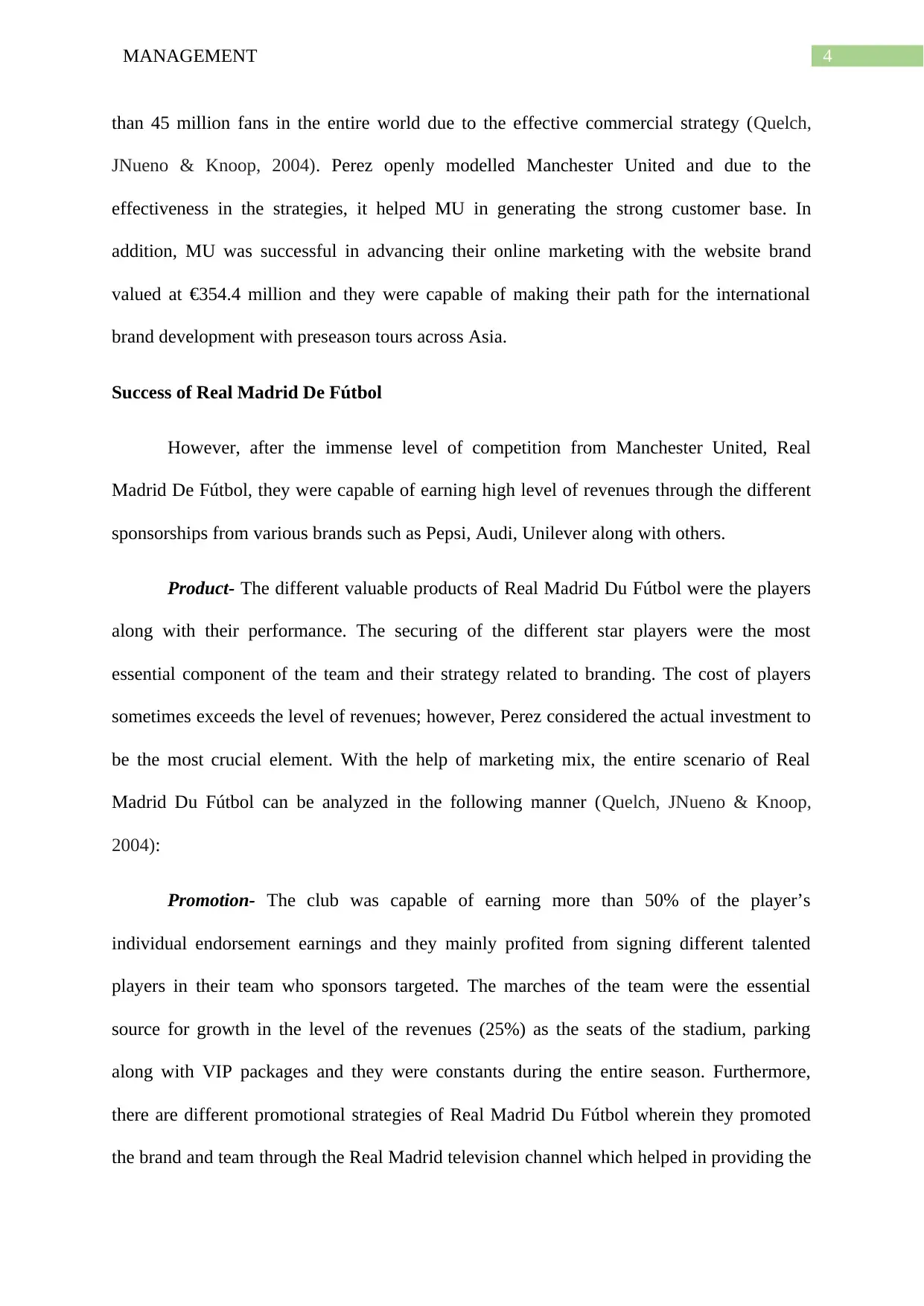
4MANAGEMENT
than 45 million fans in the entire world due to the effective commercial strategy (Quelch,
JNueno & Knoop, 2004). Perez openly modelled Manchester United and due to the
effectiveness in the strategies, it helped MU in generating the strong customer base. In
addition, MU was successful in advancing their online marketing with the website brand
valued at €354.4 million and they were capable of making their path for the international
brand development with preseason tours across Asia.
Success of Real Madrid De Fútbol
However, after the immense level of competition from Manchester United, Real
Madrid De Fútbol, they were capable of earning high level of revenues through the different
sponsorships from various brands such as Pepsi, Audi, Unilever along with others.
Product- The different valuable products of Real Madrid Du Fútbol were the players
along with their performance. The securing of the different star players were the most
essential component of the team and their strategy related to branding. The cost of players
sometimes exceeds the level of revenues; however, Perez considered the actual investment to
be the most crucial element. With the help of marketing mix, the entire scenario of Real
Madrid Du Fútbol can be analyzed in the following manner (Quelch, JNueno & Knoop,
2004):
Promotion- The club was capable of earning more than 50% of the player’s
individual endorsement earnings and they mainly profited from signing different talented
players in their team who sponsors targeted. The marches of the team were the essential
source for growth in the level of the revenues (25%) as the seats of the stadium, parking
along with VIP packages and they were constants during the entire season. Furthermore,
there are different promotional strategies of Real Madrid Du Fútbol wherein they promoted
the brand and team through the Real Madrid television channel which helped in providing the
than 45 million fans in the entire world due to the effective commercial strategy (Quelch,
JNueno & Knoop, 2004). Perez openly modelled Manchester United and due to the
effectiveness in the strategies, it helped MU in generating the strong customer base. In
addition, MU was successful in advancing their online marketing with the website brand
valued at €354.4 million and they were capable of making their path for the international
brand development with preseason tours across Asia.
Success of Real Madrid De Fútbol
However, after the immense level of competition from Manchester United, Real
Madrid De Fútbol, they were capable of earning high level of revenues through the different
sponsorships from various brands such as Pepsi, Audi, Unilever along with others.
Product- The different valuable products of Real Madrid Du Fútbol were the players
along with their performance. The securing of the different star players were the most
essential component of the team and their strategy related to branding. The cost of players
sometimes exceeds the level of revenues; however, Perez considered the actual investment to
be the most crucial element. With the help of marketing mix, the entire scenario of Real
Madrid Du Fútbol can be analyzed in the following manner (Quelch, JNueno & Knoop,
2004):
Promotion- The club was capable of earning more than 50% of the player’s
individual endorsement earnings and they mainly profited from signing different talented
players in their team who sponsors targeted. The marches of the team were the essential
source for growth in the level of the revenues (25%) as the seats of the stadium, parking
along with VIP packages and they were constants during the entire season. Furthermore,
there are different promotional strategies of Real Madrid Du Fútbol wherein they promoted
the brand and team through the Real Madrid television channel which helped in providing the
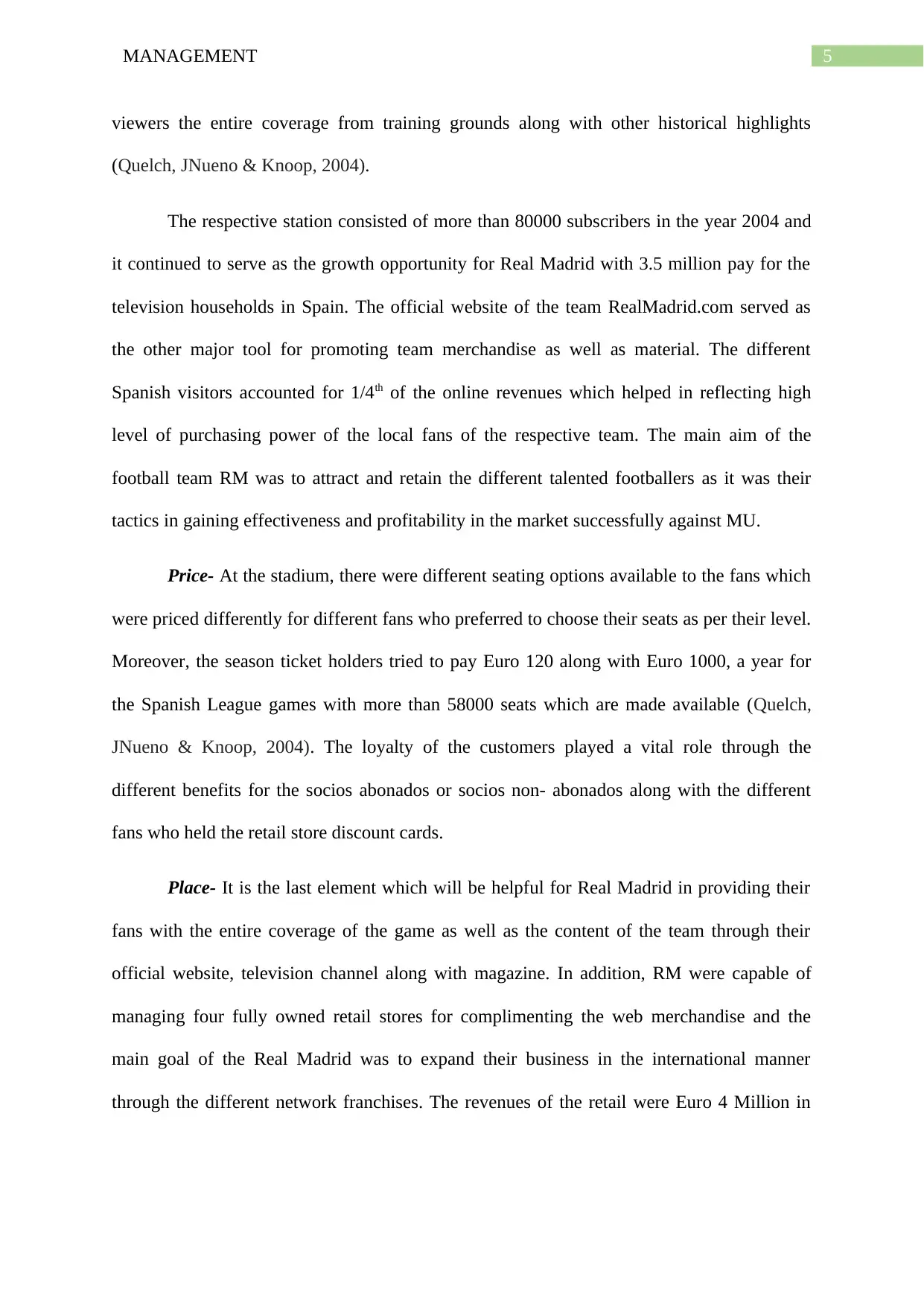
5MANAGEMENT
viewers the entire coverage from training grounds along with other historical highlights
(Quelch, JNueno & Knoop, 2004).
The respective station consisted of more than 80000 subscribers in the year 2004 and
it continued to serve as the growth opportunity for Real Madrid with 3.5 million pay for the
television households in Spain. The official website of the team RealMadrid.com served as
the other major tool for promoting team merchandise as well as material. The different
Spanish visitors accounted for 1/4th of the online revenues which helped in reflecting high
level of purchasing power of the local fans of the respective team. The main aim of the
football team RM was to attract and retain the different talented footballers as it was their
tactics in gaining effectiveness and profitability in the market successfully against MU.
Price- At the stadium, there were different seating options available to the fans which
were priced differently for different fans who preferred to choose their seats as per their level.
Moreover, the season ticket holders tried to pay Euro 120 along with Euro 1000, a year for
the Spanish League games with more than 58000 seats which are made available (Quelch,
JNueno & Knoop, 2004). The loyalty of the customers played a vital role through the
different benefits for the socios abonados or socios non- abonados along with the different
fans who held the retail store discount cards.
Place- It is the last element which will be helpful for Real Madrid in providing their
fans with the entire coverage of the game as well as the content of the team through their
official website, television channel along with magazine. In addition, RM were capable of
managing four fully owned retail stores for complimenting the web merchandise and the
main goal of the Real Madrid was to expand their business in the international manner
through the different network franchises. The revenues of the retail were Euro 4 Million in
viewers the entire coverage from training grounds along with other historical highlights
(Quelch, JNueno & Knoop, 2004).
The respective station consisted of more than 80000 subscribers in the year 2004 and
it continued to serve as the growth opportunity for Real Madrid with 3.5 million pay for the
television households in Spain. The official website of the team RealMadrid.com served as
the other major tool for promoting team merchandise as well as material. The different
Spanish visitors accounted for 1/4th of the online revenues which helped in reflecting high
level of purchasing power of the local fans of the respective team. The main aim of the
football team RM was to attract and retain the different talented footballers as it was their
tactics in gaining effectiveness and profitability in the market successfully against MU.
Price- At the stadium, there were different seating options available to the fans which
were priced differently for different fans who preferred to choose their seats as per their level.
Moreover, the season ticket holders tried to pay Euro 120 along with Euro 1000, a year for
the Spanish League games with more than 58000 seats which are made available (Quelch,
JNueno & Knoop, 2004). The loyalty of the customers played a vital role through the
different benefits for the socios abonados or socios non- abonados along with the different
fans who held the retail store discount cards.
Place- It is the last element which will be helpful for Real Madrid in providing their
fans with the entire coverage of the game as well as the content of the team through their
official website, television channel along with magazine. In addition, RM were capable of
managing four fully owned retail stores for complimenting the web merchandise and the
main goal of the Real Madrid was to expand their business in the international manner
through the different network franchises. The revenues of the retail were Euro 4 Million in
⊘ This is a preview!⊘
Do you want full access?
Subscribe today to unlock all pages.

Trusted by 1+ million students worldwide
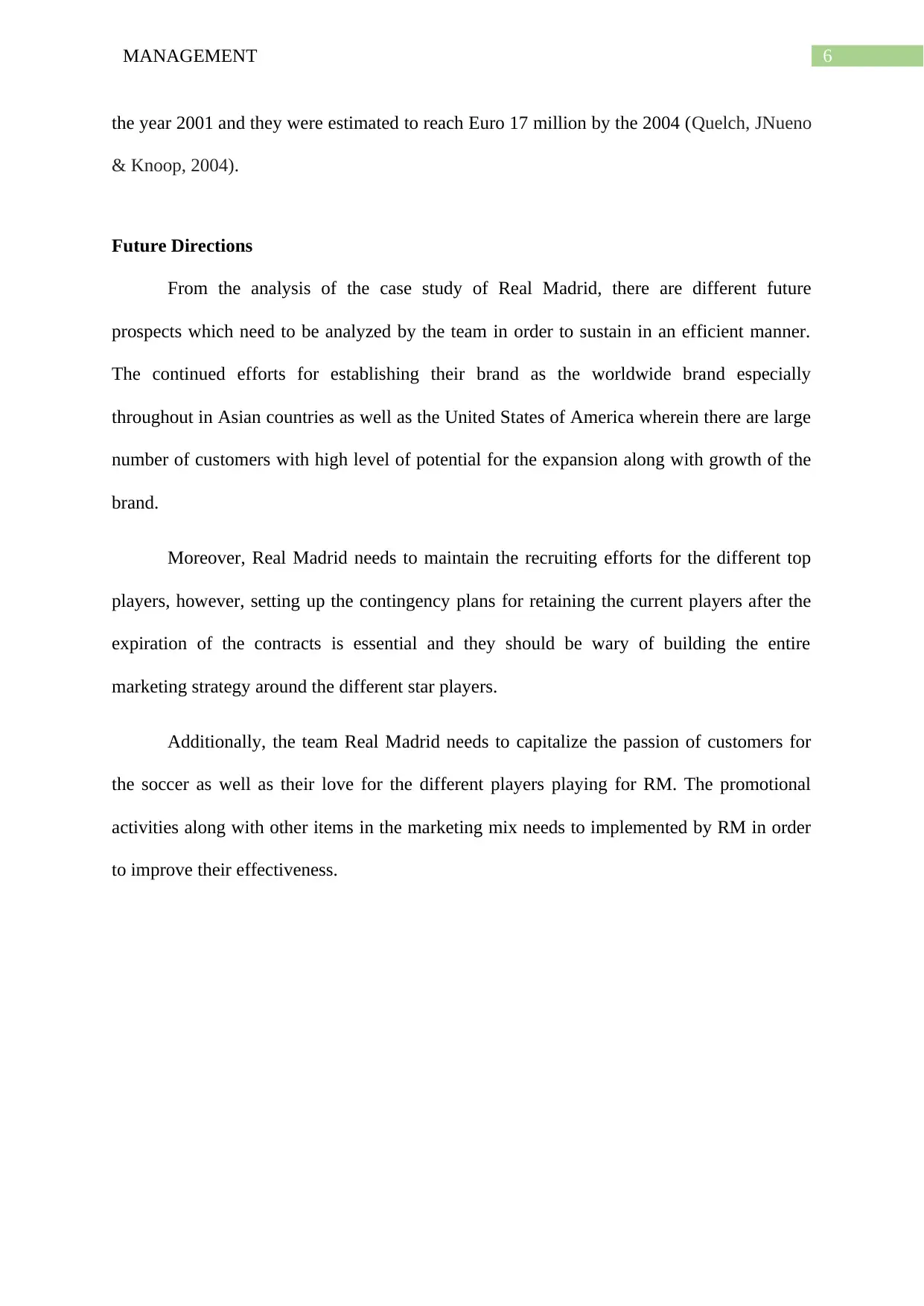
6MANAGEMENT
the year 2001 and they were estimated to reach Euro 17 million by the 2004 (Quelch, JNueno
& Knoop, 2004).
Future Directions
From the analysis of the case study of Real Madrid, there are different future
prospects which need to be analyzed by the team in order to sustain in an efficient manner.
The continued efforts for establishing their brand as the worldwide brand especially
throughout in Asian countries as well as the United States of America wherein there are large
number of customers with high level of potential for the expansion along with growth of the
brand.
Moreover, Real Madrid needs to maintain the recruiting efforts for the different top
players, however, setting up the contingency plans for retaining the current players after the
expiration of the contracts is essential and they should be wary of building the entire
marketing strategy around the different star players.
Additionally, the team Real Madrid needs to capitalize the passion of customers for
the soccer as well as their love for the different players playing for RM. The promotional
activities along with other items in the marketing mix needs to implemented by RM in order
to improve their effectiveness.
the year 2001 and they were estimated to reach Euro 17 million by the 2004 (Quelch, JNueno
& Knoop, 2004).
Future Directions
From the analysis of the case study of Real Madrid, there are different future
prospects which need to be analyzed by the team in order to sustain in an efficient manner.
The continued efforts for establishing their brand as the worldwide brand especially
throughout in Asian countries as well as the United States of America wherein there are large
number of customers with high level of potential for the expansion along with growth of the
brand.
Moreover, Real Madrid needs to maintain the recruiting efforts for the different top
players, however, setting up the contingency plans for retaining the current players after the
expiration of the contracts is essential and they should be wary of building the entire
marketing strategy around the different star players.
Additionally, the team Real Madrid needs to capitalize the passion of customers for
the soccer as well as their love for the different players playing for RM. The promotional
activities along with other items in the marketing mix needs to implemented by RM in order
to improve their effectiveness.
Paraphrase This Document
Need a fresh take? Get an instant paraphrase of this document with our AI Paraphraser
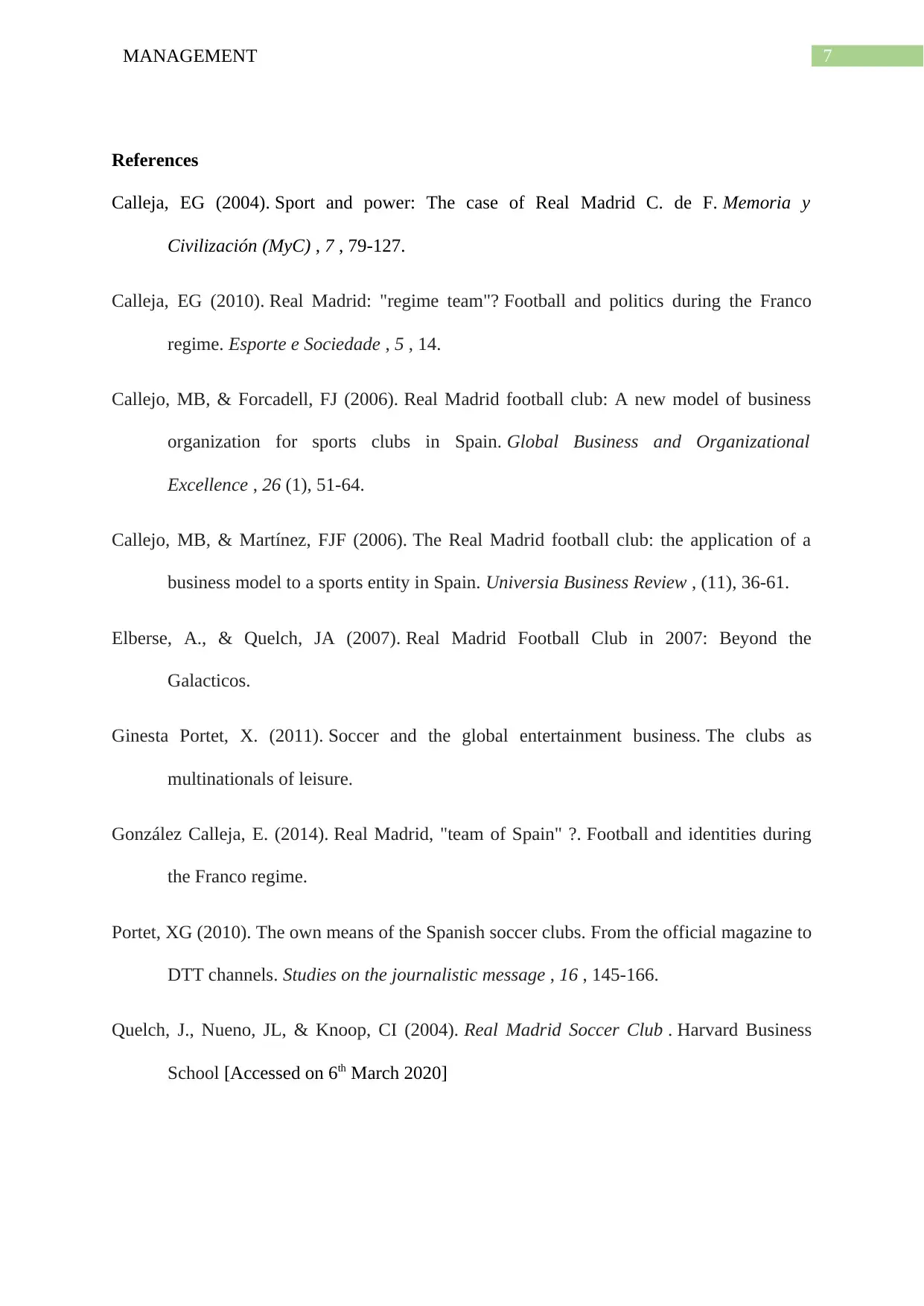
7MANAGEMENT
References
Calleja, EG (2004). Sport and power: The case of Real Madrid C. de F. Memoria y
Civilización (MyC) , 7 , 79-127.
Calleja, EG (2010). Real Madrid: "regime team"? Football and politics during the Franco
regime. Esporte e Sociedade , 5 , 14.
Callejo, MB, & Forcadell, FJ (2006). Real Madrid football club: A new model of business
organization for sports clubs in Spain. Global Business and Organizational
Excellence , 26 (1), 51-64.
Callejo, MB, & Martínez, FJF (2006). The Real Madrid football club: the application of a
business model to a sports entity in Spain. Universia Business Review , (11), 36-61.
Elberse, A., & Quelch, JA (2007). Real Madrid Football Club in 2007: Beyond the
Galacticos.
Ginesta Portet, X. (2011). Soccer and the global entertainment business. The clubs as
multinationals of leisure.
González Calleja, E. (2014). Real Madrid, "team of Spain" ?. Football and identities during
the Franco regime.
Portet, XG (2010). The own means of the Spanish soccer clubs. From the official magazine to
DTT channels. Studies on the journalistic message , 16 , 145-166.
Quelch, J., Nueno, JL, & Knoop, CI (2004). Real Madrid Soccer Club . Harvard Business
School [Accessed on 6th March 2020]
References
Calleja, EG (2004). Sport and power: The case of Real Madrid C. de F. Memoria y
Civilización (MyC) , 7 , 79-127.
Calleja, EG (2010). Real Madrid: "regime team"? Football and politics during the Franco
regime. Esporte e Sociedade , 5 , 14.
Callejo, MB, & Forcadell, FJ (2006). Real Madrid football club: A new model of business
organization for sports clubs in Spain. Global Business and Organizational
Excellence , 26 (1), 51-64.
Callejo, MB, & Martínez, FJF (2006). The Real Madrid football club: the application of a
business model to a sports entity in Spain. Universia Business Review , (11), 36-61.
Elberse, A., & Quelch, JA (2007). Real Madrid Football Club in 2007: Beyond the
Galacticos.
Ginesta Portet, X. (2011). Soccer and the global entertainment business. The clubs as
multinationals of leisure.
González Calleja, E. (2014). Real Madrid, "team of Spain" ?. Football and identities during
the Franco regime.
Portet, XG (2010). The own means of the Spanish soccer clubs. From the official magazine to
DTT channels. Studies on the journalistic message , 16 , 145-166.
Quelch, J., Nueno, JL, & Knoop, CI (2004). Real Madrid Soccer Club . Harvard Business
School [Accessed on 6th March 2020]
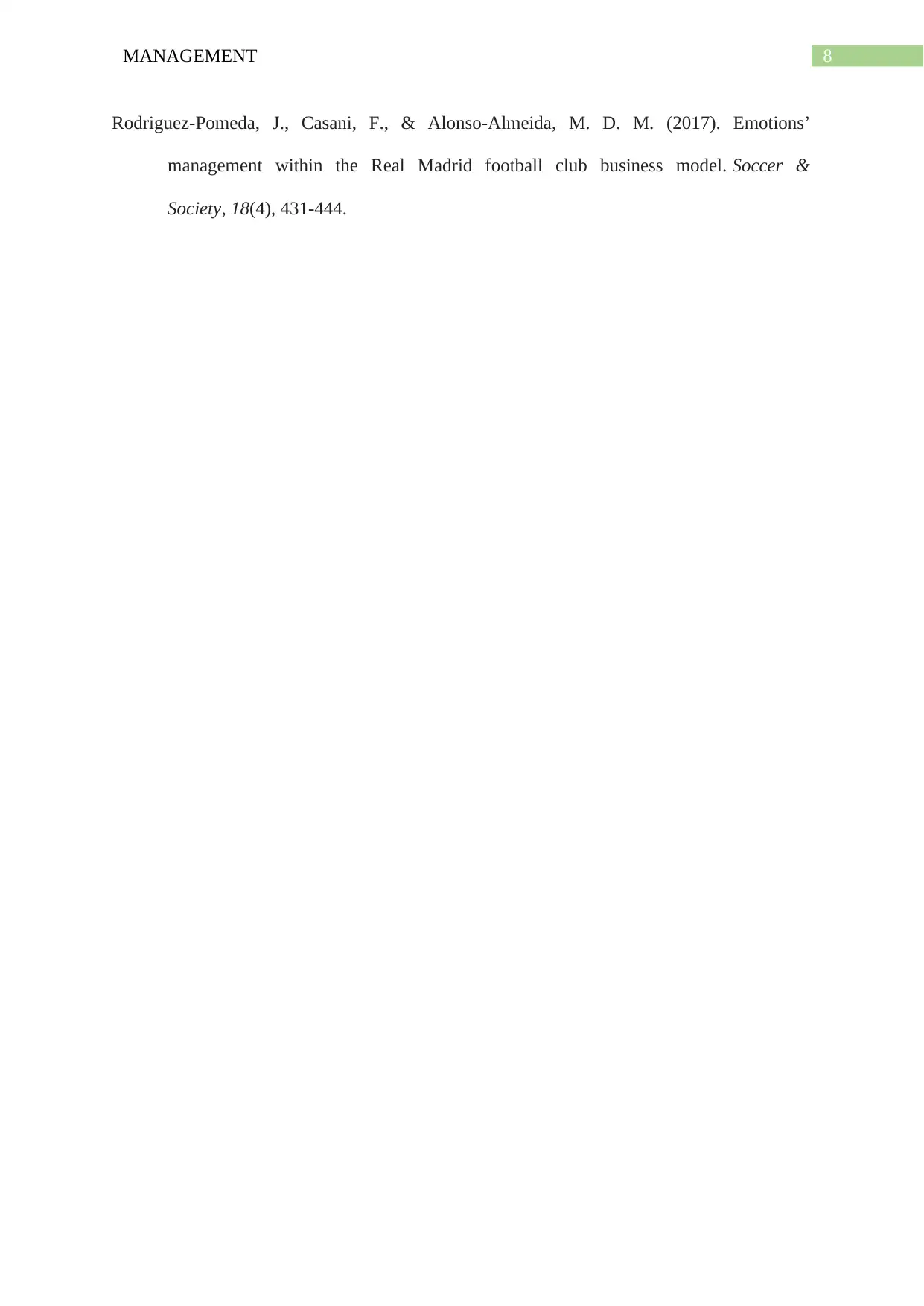
8MANAGEMENT
Rodriguez-Pomeda, J., Casani, F., & Alonso-Almeida, M. D. M. (2017). Emotions’
management within the Real Madrid football club business model. Soccer &
Society, 18(4), 431-444.
Rodriguez-Pomeda, J., Casani, F., & Alonso-Almeida, M. D. M. (2017). Emotions’
management within the Real Madrid football club business model. Soccer &
Society, 18(4), 431-444.
⊘ This is a preview!⊘
Do you want full access?
Subscribe today to unlock all pages.

Trusted by 1+ million students worldwide
1 out of 9
Your All-in-One AI-Powered Toolkit for Academic Success.
+13062052269
info@desklib.com
Available 24*7 on WhatsApp / Email
![[object Object]](/_next/static/media/star-bottom.7253800d.svg)
Unlock your academic potential
Copyright © 2020–2025 A2Z Services. All Rights Reserved. Developed and managed by ZUCOL.
